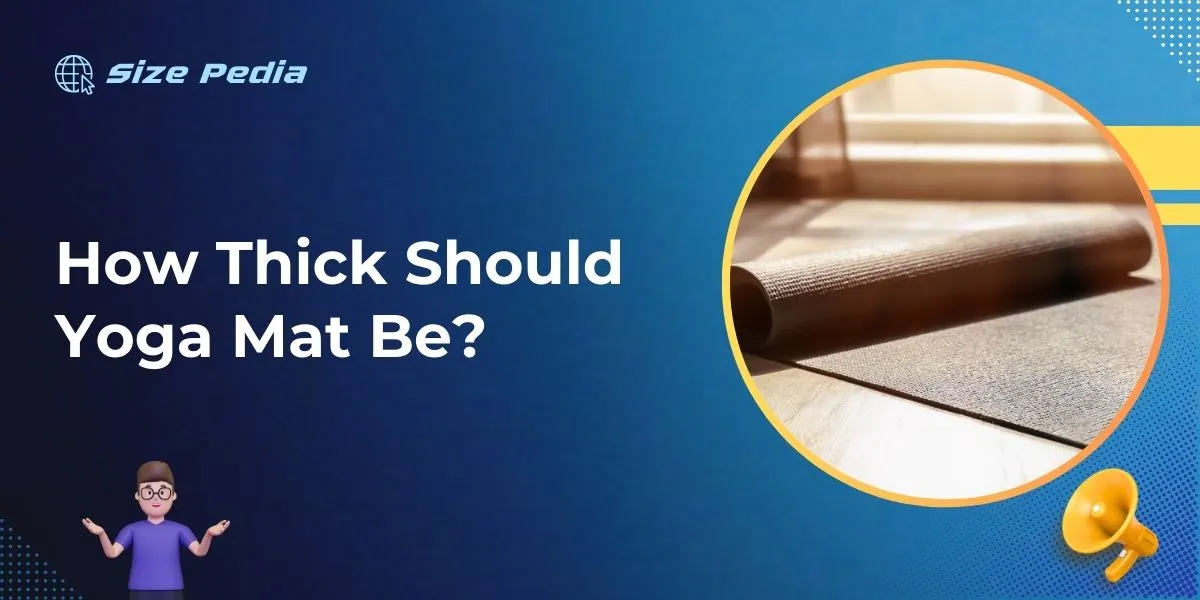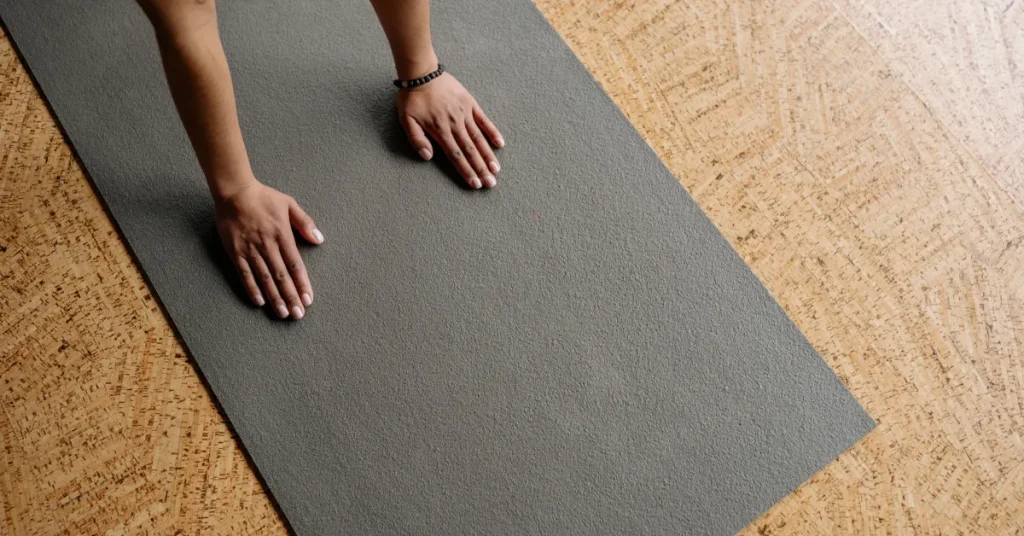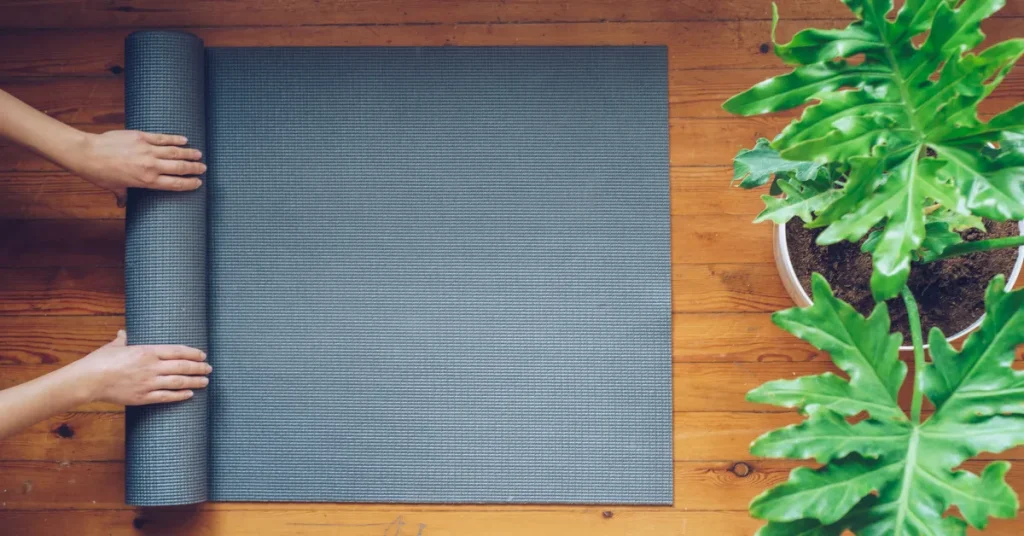The ideal thickness for a yoga mat is typically about 1/4 inch (6mm). Thicker mats may provide more cushioning but can affect stability.
Choosing the right yoga mat can significantly enhance your practice, offering the perfect blend of comfort and support. A standard yoga mat thickness is crucial for protecting your joints during various poses while ensuring you stay balanced and grounded.
Many yogis find a mat around 1/4 inch thick to be the sweet spot—it’s thin enough to help you feel connected to the floor during balance poses, yet sufficient to provide comfort for your knees during kneeling poses.
The thickness of your yoga mat is a personal preference, but important factors to consider include the types of yoga you practice, the surfaces you’ll be placing your mat on, and your individual needs for cushioning and portability.
A well-chosen yoga mat can be the foundation of a fulfilling and injury-free yoga experience.

The Importance Of Mat Thickness
The thickness of your yoga mat can make a significant difference in your practice. It’s not just a matter of comfort; it’s about finding the right balance for optimal performance and preventing injuries.
With the plethora of options available, understanding the importance of mat thickness is crucial.
Balancing Comfort And Stability
Choosing the ideal yoga mat thickness is vital for a stable and satisfying practice. A mat too thin may offer better stability for standing poses but can be uncomfortable during seated or kneeling positions.
Conversely, a thick mat provides plush comfort but can compromise your balance in poses like the Tree or Eagle. A standard thickness of about 1/8 inch (or 3 mm) tends to strike a balance, giving enough cushioning while keeping you connected to the floor.
Bold points to remember:
- Thin mats (1/16 inch): Great for balance, travel-friendly, less cushioning.
- Standard mats (1/8 inch): Balance between cushion and stability.
- Thick mats (1/4 inch): Extra cushioning, potential for reduced stability.
Injury Prevention And Joint Protection
Mat thickness also plays a key role in safeguarding your joints. A thicker mat can help prevent injuries by providing a soft surface that reduces impact on the knees, wrists, and ankles during practice.
This is particularly important for yogis with pre-existing joint concerns or those engaging in restorative or Yin yoga, where poses are held for longer periods.
An overview of benefits offered by thicker mats includes:
| Thickness | Benefits |
| 1/4 inch (6mm) | Enhanced joint protection, suitable for sensitive practitioners |
| 1/2 inch (12mm) | Maximum cushioning, ideal for therapeutic practices |
Carefully consider mat thickness to ensure a safe and enjoyable practice. Joint-friendly options are available without sacrificing performance. Remember, the best yoga mat supports both your body and your yoga style, so choose wisely.
Types Of Yoga And Mat Thickness Correlation
Yogis know that mat thickness impacts practice. Discover how different types of yoga require various mat densities. Navigate through a sea of mats with our expert guide. Find the perfect match to enhance your flow.
Mat Recommendations For Different Yoga Styles
The right mat is out there! Your yoga style dictates the necessary thickness. Prioritize comfort and stability. Fine-tune your practice with the ideal mat.
- Hatha or Iyengar: Go for thicker mats. They provide cushioning for longer poses.
- Vinyasa or Ashtanga: Opt for thinner, denser mats. They ensure solid grounding.
- Bikram or Hot Yoga: Choose thinner mats. They offer better heat resistance and grip.
- Restorative or Yin: Select thicker mats. They provide ultimate comfort during prolonged periods.
- Prenatal Yoga: Extra thick mats are best. They give support and cushioning for joints.
Intensive Practices Vs. Gentle Routines
Yoga intensity varies. Mat thickness should align with your routine. Strike a balance between support and connection to the floor.
| Practice Type | Preferred Thickness |
| Intensive Practices (e.g., Power Yoga) | 3-4mm (firmer for stability) |
| Gentle Routines (e.g., Yin Yoga) | 5-6mm (thicker for extra cushioning) |
Material Matters
Finding the perfect yoga mat often starts with a choice of material.
Not all yoga mats are made alike. Material differences impact cushion, grip, and overall comfort.
Your yoga practice deserves the best surface. Let’s dive into the world of common materials and how they shape your workout experience.
Common Yoga Mat Materials
- PVC (Polyvinyl Chloride) – Durable and offers good grip.
- TPE (Thermoplastic Elastomer) – Eco-friendlier option, lightweight.
- Natural Rubber – Supportive with excellent elasticity.
- Cork – Natural grip that increases with sweat.
- Jute – Sustainable and has a unique texture.
- Cotton – Traditional, often used for softer mats.
How Material Affects Thickness And Comfort
The choice of material greatly influences mat thickness. Thickness defines comfort level and stability.
Here’s how materials weigh in:
| Material | Thickness | Comfort |
| PVC | 3-6mm | Comfy for extended sessions, durable. |
| TPE | 3-5mm | Softer, lighter cushion. |
| Natural Rubber | 4-5mm | Dense, supportive. |
| Cork | 3-5mm | Firm with natural give. |
| Jute | 4-5mm | Firmer feel, good for balancing. |
| Cotton | 2-5mm | Softest option, molds to the body. |
Whether you opt for the traditional cotton or the modern PVC, consider your personal comfort and the types of yoga you practice.
By exploring material options, you ensure that your mat’s thickness supports your yoga journey.
Decoding The Measurements

Decoding the Measurements of a yoga mat might seem straightforward, but it is a critical factor in your yoga practice. The right thickness impacts comfort, stability, and ease of transport.
Understanding standard thickness options helps you make an informed choice tailored to your personal needs.
Standard Thickness Options
- Thin Mats (1/16 inch): Great for balance.
- Standard Mats (1/8 inch): Blend support and portability.
- Thick Mats (1/4 inch): Max comfort for joints.
- Extra Thick Mats (1/2 inch): For sensitive knees and elbows.
When To Choose Thicker Or Thinner Mats
| Mat Thickness | Choose When |
| Thinner Mats (1/16 inch) | Traveling often or doing balancing poses. |
| Standard Mats (1/8 inch) | You want a mix of cushion and stability. |
| Thicker Mats (1/4 inch) | Your practice involves a lot of floor work |
| Extra Thick Mats (1/2 inch) | You have joint pain or need extra cushioning. |
Thicker yoga mats cushion your body while thinner ones provide a firm grip on the floor. Your choice defines your yoga experience. For dynamic or balance-focused yoga, lean towards thinner mats. For therapeutic practices, consider thicker varieties.
Personal Factors To Consider
Choosing the right yoga mat thickness is not one-size-fits-all. Your unique body and yoga practice require tailored support. Let’s explore what personal factors you should consider.
Body Sensitivity And Preference
Body sensitivity plays a crucial role in selecting a mat. Consider the following:
- Knee pain: Opt for a thicker mat to cushion joints.
- Back discomfort: A supportive mat relieves pressure during poses.
- Preference for floor connection: A thinner mat increases stability for balancing poses.
Select a mat that feels comfortable and supportive for your practice.
Impact Of Weight And Height
Your weight and height affect mat choice:
| Weight | Height | Recommended Thickness |
| Lighter Weight | Shorter Height | Medium thickness for balance without sinking. |
| Heavier Weight | Taller Height | Thicker mat to ensure comfort and joint protection. |
Align mat thickness with your body’s needs for a better yoga experience.
Care And Maintenance Of Your Yoga Mat

Caring for a yoga mat is vital to ensure it supports your practice for years to come. Maintaining its thickness and comfort directly impacts your yoga experience.
Cleaning Tips For Longevity
Keeping your mat clean boosts its lifespan and maintains its grip. Follow these simple cleaning tips:
- Use a gentle cleanser. Mix water with mild soap or a few drops of essential oils.
- Wipe down regularly. After each session, use a cloth to remove sweat and oils.
- Air dry completely. Ensure your mat is fully dry before rolling it up to prevent mold and odors.
- Deep clean monthly. Submerge in soapy water and rinse well for a thorough cleanse.
Storage Solutions To Maintain Shape
Storing your mat correctly keeps it flat and ready for use. These storage solutions help:
- Roll, don’t fold. Rolling prevents creases and keeps the mat surface even.
- Use a mat bag. A bag protects from dust and simplifies transport.
- Keep it cool. Store in a cool, dry area away from direct sunlight.
- Avoid heavy items. Don’t place items on your mat to prevent permanent dents.
FAQs About How Thick Should Yoga Mat Be
What Is Ideal Thickness Of Yoga Mat?
The ideal thickness for a yoga mat generally ranges from 1/8 inch to 1/4 inch. This provides a balance between cushioning and stability.
Is 1 2 Inch Too Thick For Yoga Mat?
A 1/2 inch yoga mat may be too thick for stability in standing poses; thinner mats often provide better support.
Is 4mm Thick For A Yoga Mat?
A 4mm yoga mat offers a balance of cushioning and portability, considered standard thickness for regular practice.
Can A Yoga Mat Be Too Thin?
Yes, a yoga mat can be too thin. Thin mats may not provide sufficient cushioning for comfort during poses, potentially causing joint pain.
Conclusion
Selecting the ideal yoga mat thickness enhances your practice and comfort. Aim for a balance between cushioning and stability. A standard 1/8 inch mat suits most, while a thicker option supports joint sensitivity.
Your personal needs dictate the perfect choice, ensuring a satisfying and effective yoga journey.
Resources:
1. https://www.nccih.nih.gov/health/yoga-what-you-need-to-know
